Page 97 of 157
Parking brake fluid
Check the fluid level only if there is
visible signs of fluid leakage. If
necessary, fill the parking brake
assembly to the bottom of the filler
plug hole (B) (located on the driver
side of the transmission). Refer to
Technical specificationsin the
Capacities and Specifications
chapter for the proper fluid type.
Note:Do not fill the parking brake through the vent plug (A) (located
on top of the transmission).
POWER STEERING FLUID CHECK
1. Start the engine and let it run until it reaches normal operating
temperature (the engine coolant temperature gauge indicator will be
near the center of the normal area between H and C).
2. While the engine idles, turn the steering wheel left and right several
times.
3. Turn the engine off.
A
B
96Maintenance
2013 Motorhome(mot)
Owners Guide gf, 1st Printing
USA(fus)
Page 100 of 157
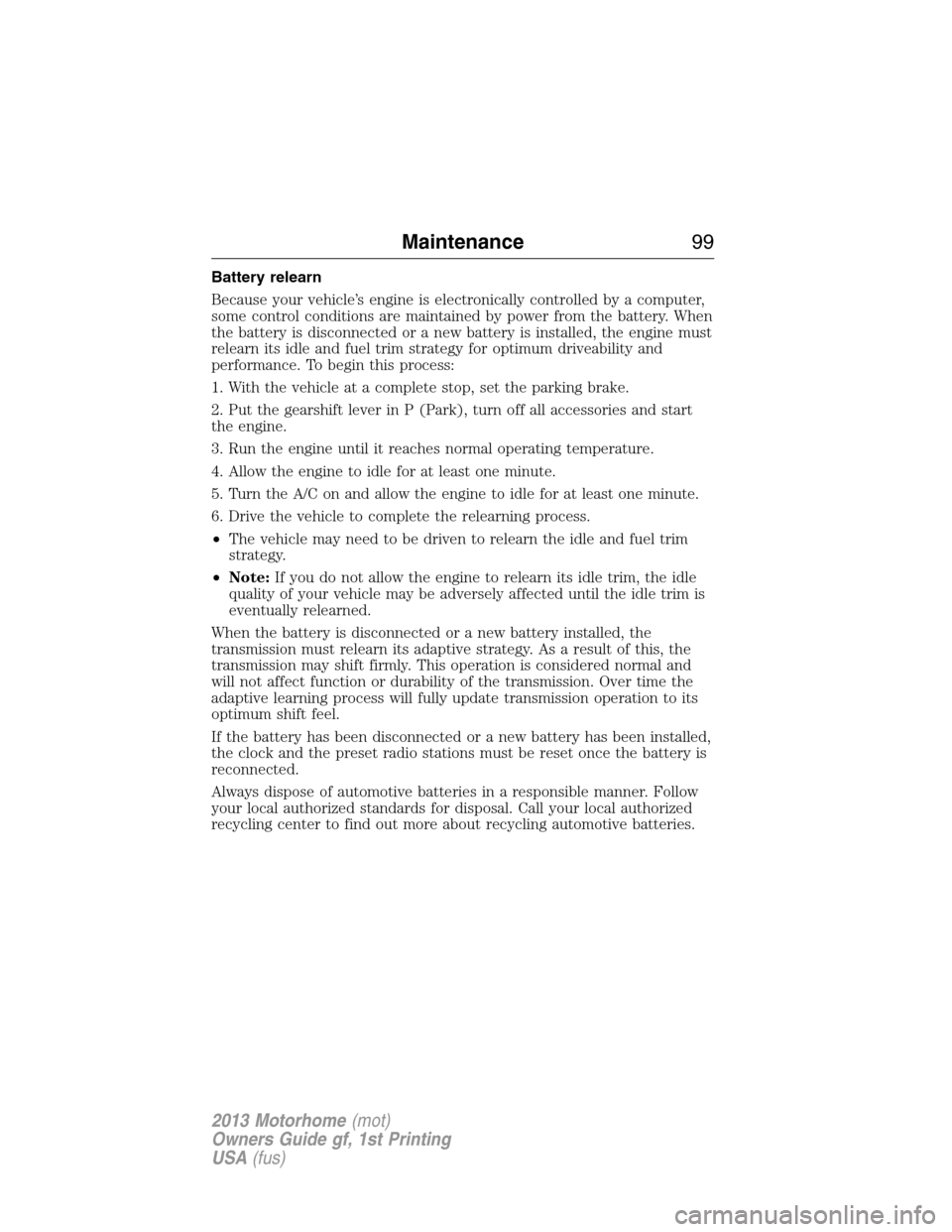
Battery relearn
Because your vehicle’s engine is electronically controlled by a computer,
some control conditions are maintained by power from the battery. When
the battery is disconnected or a new battery is installed, the engine must
relearn its idle and fuel trim strategy for optimum driveability and
performance. To begin this process:
1. With the vehicle at a complete stop, set the parking brake.
2. Put the gearshift lever in P (Park), turn off all accessories and start
the engine.
3. Run the engine until it reaches normal operating temperature.
4. Allow the engine to idle for at least one minute.
5. Turn the A/C on and allow the engine to idle for at least one minute.
6. Drive the vehicle to complete the relearning process.
•The vehicle may need to be driven to relearn the idle and fuel trim
strategy.
•Note:If you do not allow the engine to relearn its idle trim, the idle
quality of your vehicle may be adversely affected until the idle trim is
eventually relearned.
When the battery is disconnected or a new battery installed, the
transmission must relearn its adaptive strategy. As a result of this, the
transmission may shift firmly. This operation is considered normal and
will not affect function or durability of the transmission. Over time the
adaptive learning process will fully update transmission operation to its
optimum shift feel.
If the battery has been disconnected or a new battery has been installed,
the clock and the preset radio stations must be reset once the battery is
reconnected.
Always dispose of automotive batteries in a responsible manner. Follow
your local authorized standards for disposal. Call your local authorized
recycling center to find out more about recycling automotive batteries.
Maintenance99
2013 Motorhome(mot)
Owners Guide gf, 1st Printing
USA(fus)
Page 104 of 157
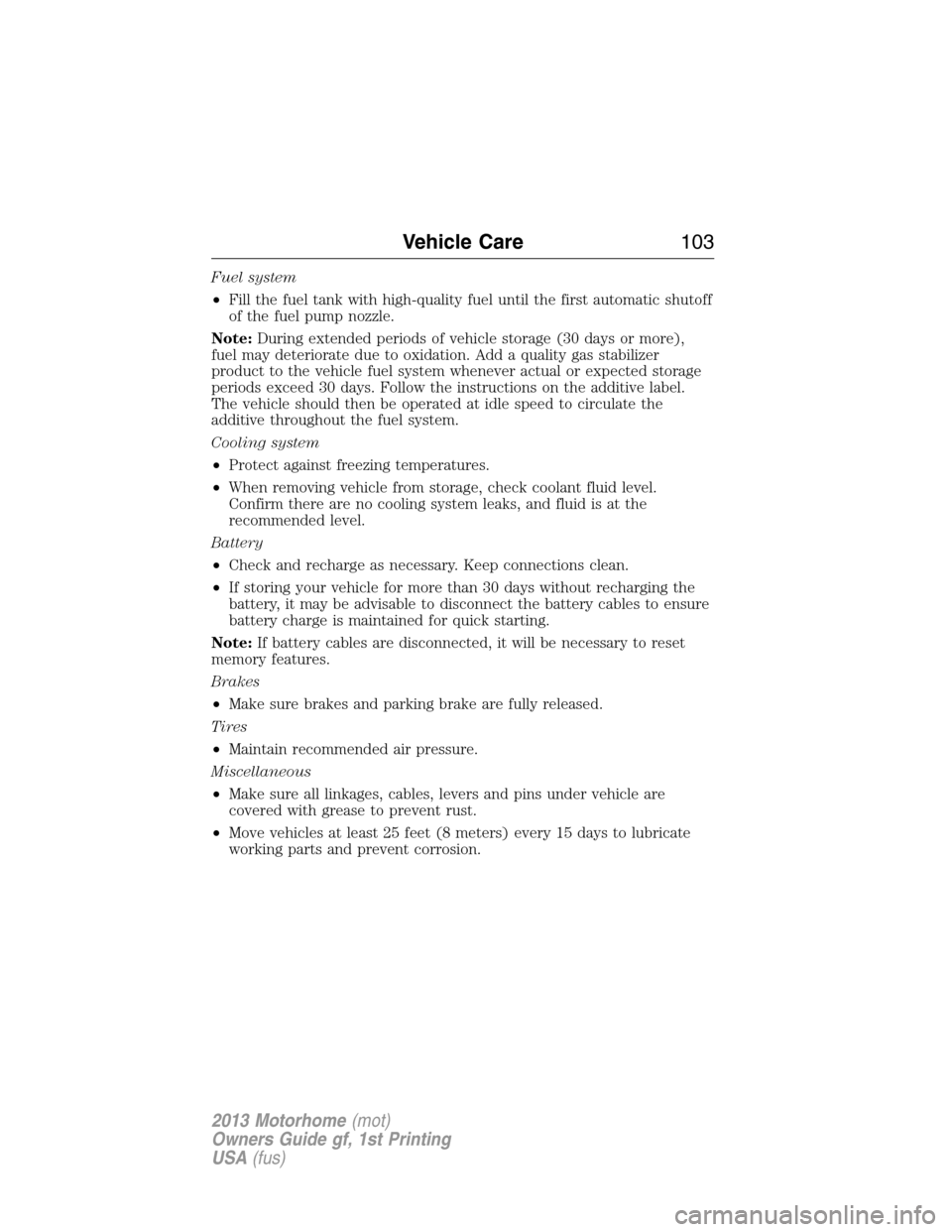
Fuel system
•Fill the fuel tank with high-quality fuel until the first automatic shutoff
of the fuel pump nozzle.
Note:During extended periods of vehicle storage (30 days or more),
fuel may deteriorate due to oxidation. Add a quality gas stabilizer
product to the vehicle fuel system whenever actual or expected storage
periods exceed 30 days. Follow the instructions on the additive label.
The vehicle should then be operated at idle speed to circulate the
additive throughout the fuel system.
Cooling system
•Protect against freezing temperatures.
•When removing vehicle from storage, check coolant fluid level.
Confirm there are no cooling system leaks, and fluid is at the
recommended level.
Battery
•Check and recharge as necessary. Keep connections clean.
•If storing your vehicle for more than 30 days without recharging the
battery, it may be advisable to disconnect the battery cables to ensure
battery charge is maintained for quick starting.
Note:If battery cables are disconnected, it will be necessary to reset
memory features.
Brakes
•Make sure brakes and parking brake are fully released.
Tires
•Maintain recommended air pressure.
Miscellaneous
•Make sure all linkages, cables, levers and pins under vehicle are
covered with grease to prevent rust.
•Move vehicles at least 25 feet (8 meters) every 15 days to lubricate
working parts and prevent corrosion.
Vehicle Care103
2013 Motorhome(mot)
Owners Guide gf, 1st Printing
USA(fus)
Page 124 of 157
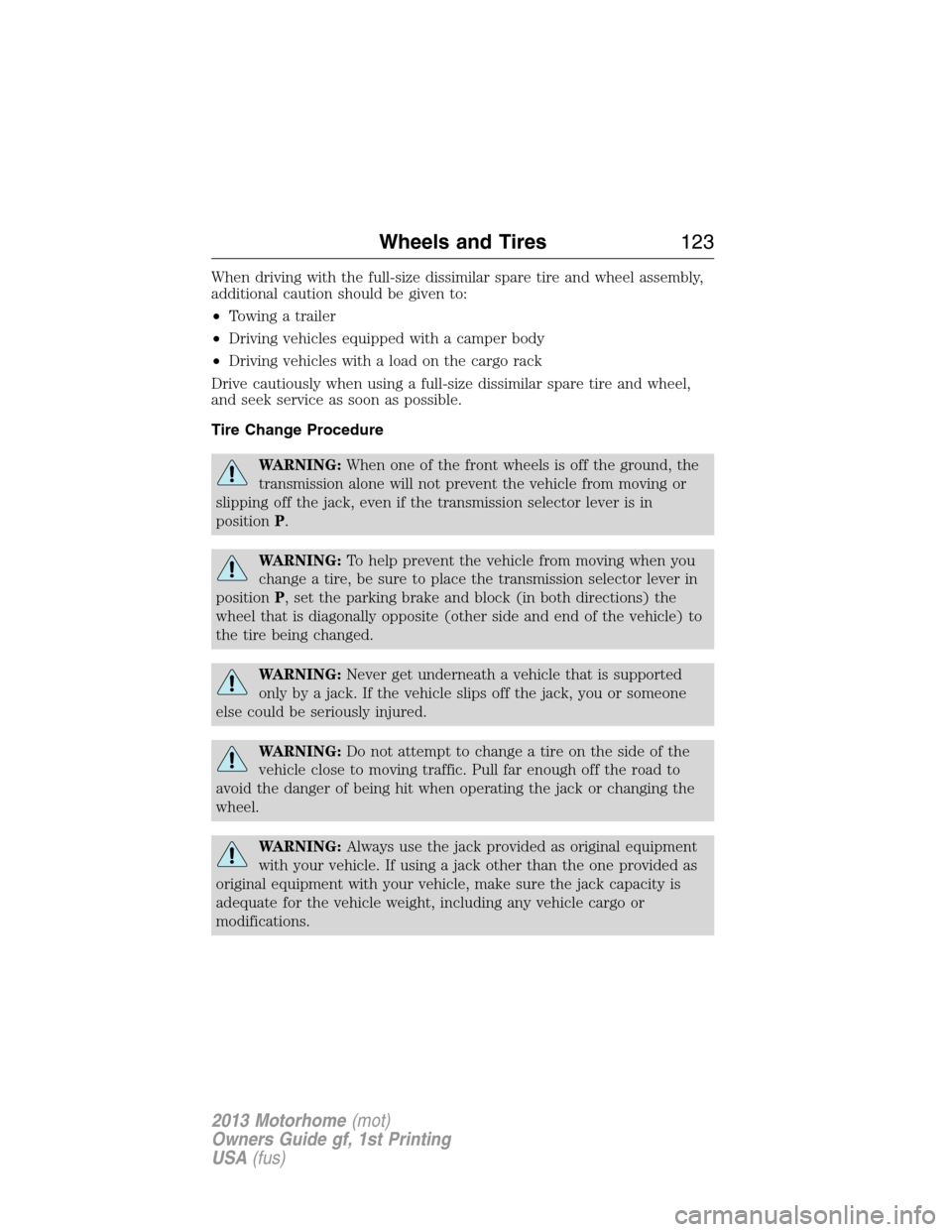
When driving with the full-size dissimilar spare tire and wheel assembly,
additional caution should be given to:
•Towing a trailer
•Driving vehicles equipped with a camper body
•Driving vehicles with a load on the cargo rack
Drive cautiously when using a full-size dissimilar spare tire and wheel,
and seek service as soon as possible.
Tire Change Procedure
WARNING:When one of the front wheels is off the ground, the
transmission alone will not prevent the vehicle from moving or
slipping off the jack, even if the transmission selector lever is in
positionP.
WARNING:To help prevent the vehicle from moving when you
change a tire, be sure to place the transmission selector lever in
positionP, set the parking brake and block (in both directions) the
wheel that is diagonally opposite (other side and end of the vehicle) to
the tire being changed.
WARNING:Never get underneath a vehicle that is supported
only by a jack. If the vehicle slips off the jack, you or someone
else could be seriously injured.
WARNING:Do not attempt to change a tire on the side of the
vehicle close to moving traffic. Pull far enough off the road to
avoid the danger of being hit when operating the jack or changing the
wheel.
WARNING:Always use the jack provided as original equipment
with your vehicle. If using a jack other than the one provided as
original equipment with your vehicle, make sure the jack capacity is
adequate for the vehicle weight, including any vehicle cargo or
modifications.
Wheels and Tires123
2013 Motorhome(mot)
Owners Guide gf, 1st Printing
USA(fus)
Page 125 of 157
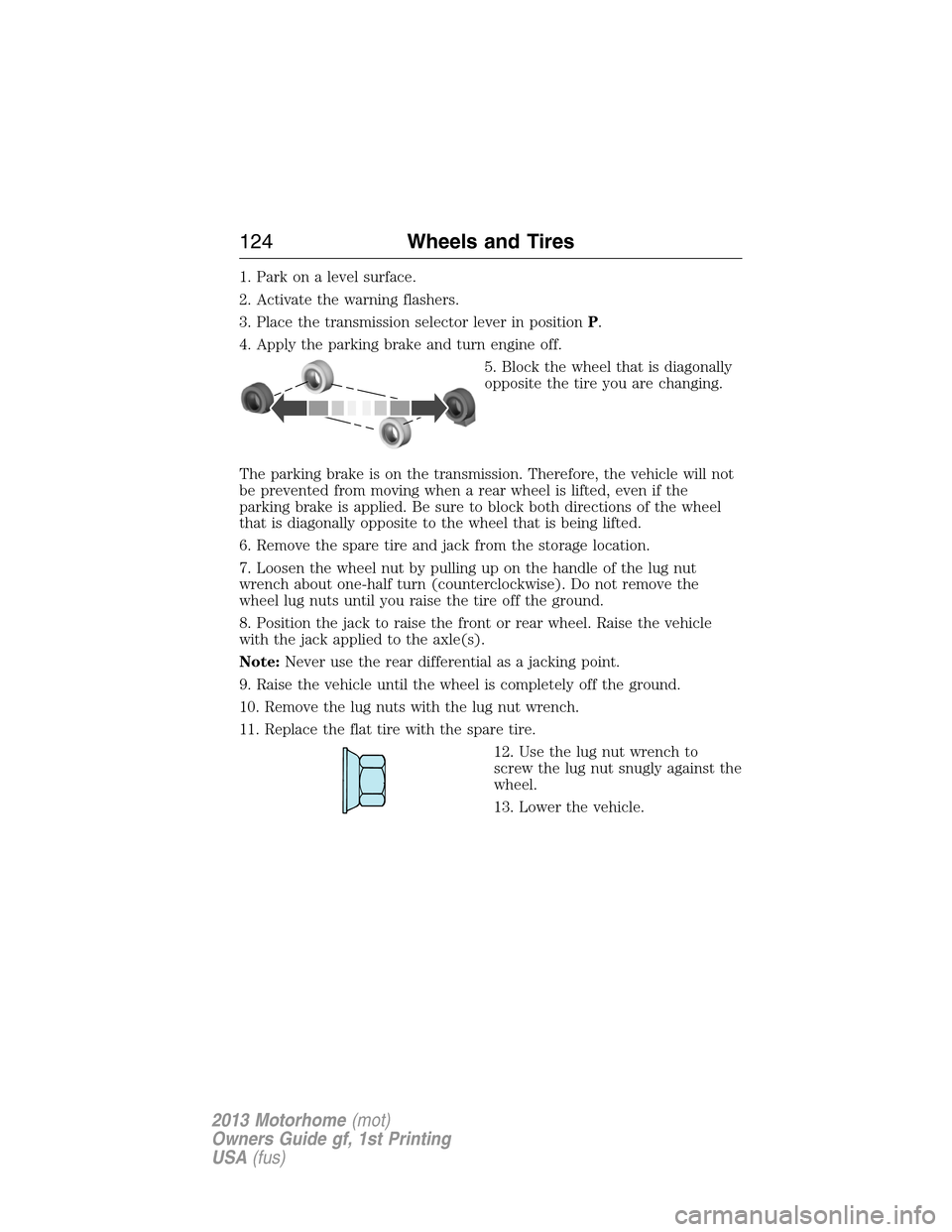
1. Park on a level surface.
2. Activate the warning flashers.
3. Place the transmission selector lever in positionP.
4. Apply the parking brake and turn engine off.
5. Block the wheel that is diagonally
opposite the tire you are changing.
The parking brake is on the transmission. Therefore, the vehicle will not
be prevented from moving when a rear wheel is lifted, even if the
parking brake is applied. Be sure to block both directions of the wheel
that is diagonally opposite to the wheel that is being lifted.
6. Remove the spare tire and jack from the storage location.
7. Loosen the wheel nut by pulling up on the handle of the lug nut
wrench about one-half turn (counterclockwise). Do not remove the
wheel lug nuts until you raise the tire off the ground.
8. Position the jack to raise the front or rear wheel. Raise the vehicle
with the jack applied to the axle(s).
Note:Never use the rear differential as a jacking point.
9. Raise the vehicle until the wheel is completely off the ground.
10. Remove the lug nuts with the lug nut wrench.
11. Replace the flat tire with the spare tire.
12. Use the lug nut wrench to
screw the lug nut snugly against the
wheel.
13. Lower the vehicle.
124Wheels and Tires
2013 Motorhome(mot)
Owners Guide gf, 1st Printing
USA(fus)
Page 130 of 157
Item CapacityFord part name or
equivalentFord part number /
Ford specification
Engine oil
3,4
7.0 quarts
(6.6L)Motorcraft�SAE 5W-20
Premium Synthetic Blend
Motor Oil (US)
Motorcraft�SAE 5W-20
Super Premium Motor Oil
(Canada)XO-5W20-QSP (US)
CXO-5W20-LSP12
(Canada) /
WSS-M2C945-A
Automatic transmission
TorqShift�5-speed
5,6
18.2 quarts (17.2L)
Motorcraft�
MERCON�LV AT FXT-10-QLV /
MERCON�LV
WSS-M2C938-A
Power steering fluidKeep in FULL
range on dipstick
Parking brake assemblyFill to bottom of fill
plug holeMotorcraft�
MERCON�VATFXT-5-QM /
MERCON�V
WSS-M2C938-A
Rear axle
7,8
4.0 quarts
(3.9L)
(Dana M80)
Motorcraft�SAE 75W-140
Synthetic Rear Axle
LubricantXY-75W140-QL /
WSL-M2C192-A and GL-5 8.0 quarts
(7.6L)
(Dana S110)
7.0 quarts
(6.6L)
(Dana S130)
16.0 quarts (15.1L)
(Dana Spicer
17060S)
Capacities and Specifications129
2013 Motorhome(mot)
Owners Guide gf, 1st Printing
USA(fus)
Page 131 of 157
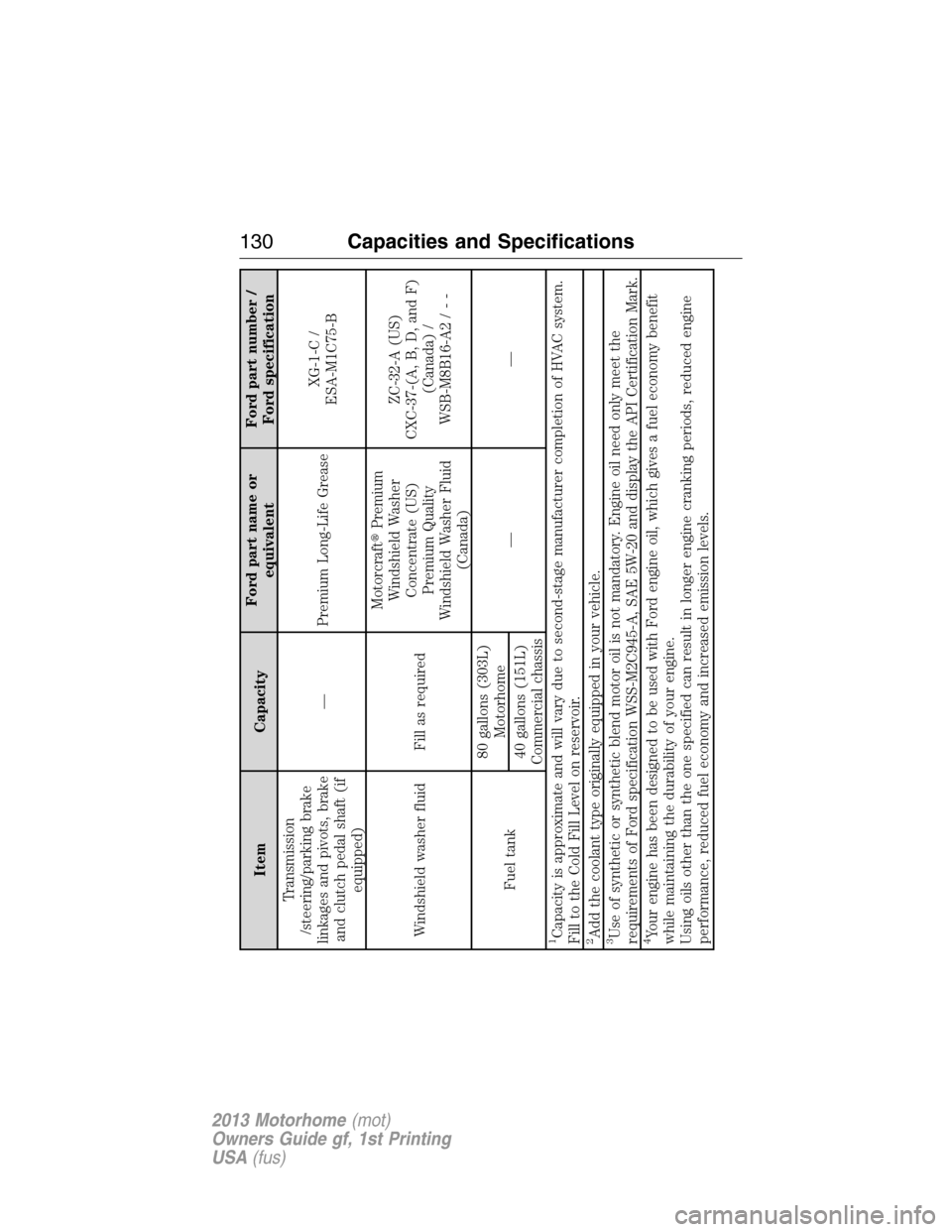
Item CapacityFord part name or
equivalentFord part number /
Ford specification
Transmission
/steering/parking brake
linkages and pivots, brake
and clutch pedal shaft (if
equipped)— Premium Long-Life GreaseXG-1-C /
ESA-M1C75-B
Windshield washer fluid Fill as requiredMotorcraft�Premium
Windshield Washer
Concentrate (US)
Premium Quality
Windshield Washer Fluid
(Canada)ZC-32-A (US)
CXC-37-(A, B, D, and F)
(Canada) /
WSB-M8B16-A2 / - -
Fuel tank80 gallons (303L)
Motorhome
——
40 gallons (151L)
Commercial chassis
1Capacity is approximate and will vary due to second-stage manufacturer completion of HVAC system.
Fill to the Cold Fill Level on reservoir.2Add the coolant type originally equipped in your vehicle.3Use of synthetic or synthetic blend motor oil is not mandatory. Engine oil need only meet the
requirements of Ford specification WSS-M2C945-A, SAE 5W-20 and display the API Certification Mark.4Your engine has been designed to be used with Ford engine oil, which gives a fuel economy benefit
while maintaining the durability of your engine.
Using oils other than the one specified can result in longer engine cranking periods, reduced engine
performance, reduced fuel economy and increased emission levels.
130Capacities and Specifications
2013 Motorhome(mot)
Owners Guide gf, 1st Printing
USA(fus)
Page 140 of 157

Oils, Fluids and Flushing
In many cases, fluid discoloration is a normal operating characteristic
and, by itself, does not necessarily indicate a concern or that the fluid
needs to be changed. However, discolored fluids that also show signs of
overheating and/or foreign material contamination should be inspected
immediately by a qualified expert such as the factory-trained technicians
at your dealership. Your vehicle’s oils and fluids should be changed at the
specified intervals or in conjunction with a repair. Flushing is a viable
way to change fluid for many vehicle sub-systems during scheduled
maintenance. It is critical that systems are flushed only with new fluid
that is the same as that required to fill and operate the system, or using
a Ford-approved flushing chemical.
Owner Checks and Services
Certain basic maintenance checks and inspections should be performed
every month or at six months intervals.
Check Every Month
Engine oil level.
Function of all interior and exterior lights.
Tires (including spare) for wear and proper pressure.
Windshield washer fluid level.
Check Every Six Months
Battery connections. Clean if necessary.
Body and door drain holes for obstructions. Clean if necessary.
Cooling system fluid level and coolant strength.
Door weatherstrips for wear. Lubricate if necessary.
Hinges, latches and outside locks for proper operation. Lubricate if
necessary.
Parking brake for proper operation.
Safety belts and seat latches for wear and function.
Safety warning lamps (brake, ABS, airbag, safety belt) for operation.
Washer spray and wiper operation. Clean or replace blades as
necessary.
Scheduled Maintenance139
2013 Motorhome(mot)
Owners Guide gf, 1st Printing
USA(fus)